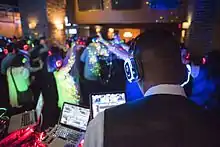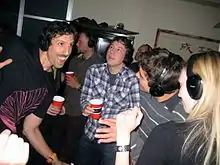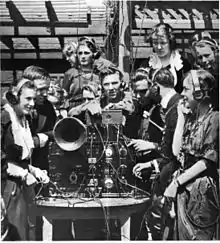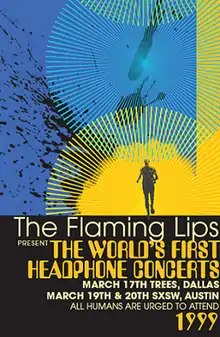Silent disco
A silent disco or silent rave is an event where people dance to music listened to on wireless headphones.[1] Rather than using a speaker system, music is broadcast via a radio transmitter with the signal being picked up by wireless headphone receivers worn by the participants. Those without the headphones hear no music, giving the effect of a room full of people dancing to nothing.

In the earliest days of silent discos, before 2005, there would be only one channel available to listen to music through. Over time, the technology moved along to where there were two, and later technology allowed for a third channel that three separate DJs could broadcast over at the same time.
Silent discos are popular at music festivals as they allow dancing to continue past noise curfews. Similar events are "mobile clubbing" gatherings, where a group of people dance to the music on their personal music players.
History

An early reference in fiction is Astroboy's 1967 Japanese science fiction story The Summer of 1993, where the titular character attends a party where everyone wears headphones.[2]
The concept was used by eco-activists in the early 1990s, utilizing headphones at outdoor parties to minimize noise pollution and disturbance to the local wildlife.
In 1994, the Glastonbury Festival linked its on-site radio station to the video screen sited next to the Main Stage, allowing festival goers to watch late night World Cup football and music videos on the giant screen after the sound curfew by using their own portable radios. The idea was the brainchild of the project manager from Proquip, who supplied the giant screen, and engineers from Moles Recording Studio in Bath, Somerset, who were working with Radio Avalon.

In May 2000, BBC Live Music held a "silent gig" at Chapter Arts Centre in Cardiff, where the audience listened to a band, Rocketgoldstar, and various DJs through headphones.[3]
In May 2002 artist Meg Duguid hosted Dance with me... a silent dance party at the Museum of Contemporary Art Chicago where she created an outdoor club installation complete with velvet ropes and glow rope in which a DJ spun a transmission to wireless headsets that audience members put on and danced to.[4][5][6] Duguid threw a second dance party at the Museum of Contemporary Art, Chicago the following year, entitled Dueling DJs where two DJS simultaneously spun two separate musical transmissions various wireless headsets that audience members put on and danced to. This performance was repeated the following year (2004) at the Chicago Cultural Center.[7]
The term "silent disco" has been in existence since at least 2005 with Bonnaroo Music Festival advertising such an event that year with DJ’s Motion Potion, Quickie Mart and DJ medi4 and headphones provided by KOSS.[8] In recent years Silent Events has presented Bonaroo's Silent Disco.[9]
In the Netherlands, the traveling arts and culture festival De Parade already featured a "stille disco" [silent disco] earlier, for example in 2003.[10] Dutch DJs Nico Okkerse and Michael Minton have been described as "the pioneers ... in the legend of silent disco" because they started "stille disco" events in 2002.[11] Okkerse claims his company 433fm.com "created Silent Disco in 2002"[12] and its site does have photos from such events going back to at least 2003.[13]
United States
Cisco Sa from Silent Discotheque [14] claims that he is the original silent disco concept creator. Nico Okkerse, the one claiming to be the silent disco pioneer, literally robbed the discotheque with headphones project from Cisco Sa and label it silent disco. Okkerse told the whole World that he invented silent disco and was the great pioneer, he just forgot to say that he invented the label for Cisco Sa's innovative concept.
HUSHconcerts (previously, Silent Frisco) was the first company to produce a multi-city Silent Disco tour in 2008 with Silent Soundclash [15] kicking off at Winter Music Conference in Miami, followed by Atlanta, Athens, Savannah, Wilmington NC, Charlottesville Va, Baltimore, New York City, Syracuse, Pittsburgh and St. Louis. During this tour, the company became the first to produce American silent discos on a beach (Miami Beach) and a boat (the Rocksoff Cruise in New York Harbor).[16]
The Oxford Dictionary Online added the term "silent disco" to their website in February 2011.[1] As interest has increased, there has been a rise in the number of companies organizing parties and providing events with wireless headphones. Some companies have offered home kits.[17]
Becoming ever more popular, Silent Discos continue to be featured in popular media, including NBC's Brooklyn Nine-Nine, Season 2, Episode 5 "The Mole";[18] Netflix's Atypical Season 1, Episode 8 "The Silencing Properties of Snow"[19] & most recently, FX's new comedy series "Dave" starring American rapper, Lil Dicky.[20]
Mobile clubbing
Another type of silent party, known as mobile clubbing, involves the gathering of a group of people in an unconventional location to dance to music which they provide themselves via a portable music device, such as an MP3 player, listened to on headphones. These flash mob gatherings may involve hundreds of people, transforming public spaces into temporary clubbing areas, in which dancers listen to their personal playlists. To an observer it would appear that the participants are dancing for no apparent reason. Mobile clubbing events are organized using mass-emails, word-of-mouth or social networking websites such as Facebook, or a combination of these methods.
The first event, organised by London-based artists Ben Cummins (also founder of Pillow Fight Club) and Emma Davis, was at London's Liverpool Street Station in September 2003.[21] Over the next five months there were a further five events at other London train stations including Waterloo, Charing Cross and London Bridge.[22]
An event in 2007 at Victoria Station, London involved 4,000 participants.[23] The event was broken up by police two hours later.
Silent Concert

A silent concert (or headphones concert) is a live music performance where the audience, in the same venue as the performing artist, listens to the music through headphones.[24] The idea originated in 1997 when Erik Minkkinen,[25][26] an electronic artist[27][28] from Paris, streamed a live concert from his closet over the internet to three listeners in Japan.[29] The concept led to a decentralized organization known as le placard ("the Cupboard"),[30] which allowed anybody to establish a streaming or listening room.[29]
The first headphone concert taking place in front of a live audience took place March 17, 1999, at Trees in Dallas, Texas. The American psychedelic band The Flaming Lips used an FM signal generator at the venue and handed out mini FM radio receivers and headphones to each member of the audience. A normal speaker system was also used so the sound could also be felt. This continued on their "International Music Against Brain Degeneration Revue" tour with mixed results, with technical problems including dead batteries and intoxicated audience members having trouble tuning to the correct frequency.[31] Another headphone concert was performed in the Chapter Arts Centre, Cardiff in April 2000 by Rocketgoldstar.[3]
Later headphone concerts used specially designed wireless 3-channel headphones, better in-house custom made transmitters and no speakers or any live PA in the venue. Major events hosting headphone concerts included the 2005 Glastonbury Festival, 2010 Shift Festival in Switzerland,[32] the 2011-12 Van's Warp Tours across North America, Sensoria 2012 in Sheffield, UK, the 2012 Bonnaroo Music Festival in Tennessee and the Hoxeyville Music Fest in Michigan.[33] In 2012, Kid Koala performed a "Space Cadet Headphone Concert tour" around the world.[34]
A variant of the headphone concert involves live bands competing for the audience, who are able to choose which band's frequency to receive. In August 2008, the first silent Battle of the Bands was held at The Barfly music venue in Cardiff.[35] The event featured bands going directly head-to-head, with a stage at each end of the venue, allowing gig-goers to choose which group they wished to listen to.
Silent theatre
Theatre and performance companies are now beginning to exploit silent disco technology as well. In 2009, with the help of SilentArena Ltd, Feral Productions began using an experimental approach – a mixture of narrative-led performance, sound art and guided exhibit. Their first performance, The Gingerbread House, took the audience from The Courtyard, Hereford on a journey through a multi-storey car park in the centre of Hereford. In 2010, their second show, Locked (Rapunzel’s Lament), took place in a children’s playground, also in Hereford. Silent theatre techniques are now being used by companies in Liverpool, Birmingham and Glasgow.[36][37]
In 2015 Lincoln Center staged a production of the Rocky Horror Picture Show utilizing Quiet Events Headphones,[38] where an audience wearing headphones could switch between the audio for the live performance and the soundtrack of the film version being projected behind it.[39] During the COVID-19 outbreak in 2020, in compliance with CDC guidelines, music events and theatre came to a halt. In the city of Scranton, however, the Scranton Fringe Festival found they could still follow through with their performances from behind the glass of empty store fronts by utilizing a local business, Silent Sound System, which allowed patrons to view safely from the sidewalks with the use of silent disco headphones. This event was dubbed "Fringe Under Glass." [40] The Scranton Fringe Festival and Silent Sound System worked together previously to create a silent disco event and fundraiser in the Scranton Cultural Center, one of the city's oldest buildings. The "Fringe Silent Disco" was the most attended Scranton Fringe Festival event of 2019.[41]
Silent fitness
Theatre and music weren't the only sectors hampered by the new safety guidelines brought on by the COVID-19 outbreak.[42] With people searching for a way to continue some of their normal routines like going to the gym or doing yoga, Silent Sound System provided a solution to the issue of sound dissipation and background noise for outside classes, allowing fitness and yoga classes to continue while complying with social distancing orders set in place by the state and federal government.
Silent street shows
Street performers have used the concept as a solution to overcome bans on amplification and loudspeakers on the street. In 2016, Irish band Until April began using this for their shows on the street while touring in Germany and Switzerland.[43]
Remote silent disco
Playing off of the idea of a traditional silent disco, Party Headphones took the scene to become the first company to produce a completely remote "silent disco" experience. Using Zoom video conferencing and a live, remote DJ, the company was able to successfully host the very first remote experience, to accommodate guests in an age of social distancing.[44]
References
- "silent disco - Definition of silent disco in English by Oxford Dictionaries". Oxford Dictionaries - English.
- Tezuka, Osamu; Schodt, Frederik L. (2002). Astro Boy. Dark Horse Comics. p. 2. ISBN 9781569717905.
1967 astroboy the summer of 1993.
- "BBC News - ENTERTAINMENT - BBC Music Live events unfold". news.bbc.co.uk.
- http:
- Molzahn, Laura. "Summer Solstice Celebration". Chicago Reader. Archived from the original on 13 April 2017. Retrieved 12 April 2017.
- "Dance with me..." megduguid.com.
- "Dueling DJs @ Cultural Center". Gapers Block: Slow Down Archive. Archived from the original on 13 April 2017. Retrieved 12 April 2017.
- Rothman, Robin A. (June 13, 2005). "Boogie Nights: 'Silent disco' is making itself heard". MTV. Retrieved June 13, 2005.
- Rubin, Courtney (June 17, 2015). "Silent Discos Let You Dance to Your Own Beat". The New York Times. Archived from the original on June 17, 2015. Retrieved June 17, 2015.
- Schmitz, Jowi (5 August 2003). "Amsterdams Parade-publiek bekijkt zichzelf". NRC.nl (in Dutch). NRC. Retrieved 21 May 2018.
- Carroll, Robert (19 November 2008). "A quiet night out". The National. The National. Retrieved 21 May 2018.
- "Nico Okkerse". LinkedIn. LinkedIn. Retrieved 21 May 2018.
- "Festival de Parade Museumpark". Radio433.com. 433fm.com. 2003. Retrieved 21 May 2018.
- "Silent Disco Original Concept Creator".
- Ojumu, Akin (2008-06-14). "Meltdown: Silent disco, big noise". The Guardian. ISSN 0261-3077. Archived from the original on 2016-06-03. Retrieved 2017-01-24.
- "Silent Soundclash, RANA, Eric Krasno & Chapter 2 Among Cruises on Rocks Off Calendar". www.jambands.com. Archived from the original on 2017-02-02. Retrieved 2017-01-24.
- Johnston, Ian (6 September 2009). "Silent disco craze spreads". Daily Telegraph. Retrieved 7 June 2010.
- "Brooklyn Nine-Nine Silent Disco". Party Headphones. Retrieved 11 June 2020.
- "Netflix's Atypical Silent Disco". Party Headphones. Retrieved 11 June 2020.
- "FX's Dave Silent Disco". Retrieved 11 June 2020.
- Mobile Clubbing website Archived 2010-01-24 at the Wayback Machine retrieved on 2009-02-28
- Mobile Clubbing Instructions retrieved on 2007-05-01
- Stewart, Tim (2007-04-05). "4,000 flash mob dancers startle commuters at Victoria". Evening Standard. Retrieved 2007-05-03.
- "[:]plug[:] (2005)". deletist.info. 2005-08-31. Archived from the original on 2005-09-24. Retrieved 2016-08-23.
- fr:Sister Iodine
- "the placard headphone festival". leplacard.org. 2005-08-31. Archived from the original on 2005-10-26. Retrieved 2005-10-26.
- "Erik Minkkinen". V2_Institute for the Unstable Media.
- "Erik Minkkinen". Discogs. Archived from the original on 2016-10-09. Retrieved 2016-08-23.
- Axline, Keith (2005-08-31). "Fest Rocks With BYO Headphones". Wired.com entertainment music news. wired magazine. Archived from the original on 2016-08-23. Retrieved 2016-08-23.
- "Google Translate". translate.google.com. Archived from the original on 2018-01-26. Retrieved 2016-08-23.
- Booker, Scott. "Partly Accurate Flaming Lips News". Archived News Relating To The Flaming Lips. Archived from the original on 2007-03-29. Retrieved 2013-02-20.
- Spirgi, Dominique. "2010 Shift Festival english program". 2010 Shift Festival website. Shift Electronic Arts Festival Postfach CH-4023 Basel Switzerland. Archived from the original on 2013-12-24. Retrieved 2009-01-10.
- Brimer, Adam. "Bonnaroo Silent Disco Day 1". knox news. Knoxnews.com. Retrieved Dec 10, 2012.
- Mlynar, Phillip (2012-04-05). "Live: Kid Koala's Space Cadet Headphone Experience Crashes In Brooklyn - New York - Music - Sound of the City". Village Voice. Retrieved 2013-02-21.
- "Silent Gig featuring Kutosis/Muscle Club and others @ Barfly : Wed 13th August". Joy Collective. Archived from the original on 2012-03-11. Retrieved 2008-08-08.
- "The Gingerbread House breaks dramatic boundaries in Hereford".
- "Feral Productions' hoping for another fairytale ending at The Courtyard in Hereford". Archived from the original on 2014-03-31.
- "Quiet Theater". Quiet Events. Quiet Events. Retrieved 3 April 2016.
- Itzkoff, Dave (2015-08-09). "'Rocky Horror' at Lincoln Center, With Headphones". The New York Times. ISSN 0362-4331. Retrieved 2015-09-25.
- https://www.pahomepage.com/top-news/fringe-festival-adapts-to-coronavirus-restrictions-held-under-glass/
- https://www.youtube.com/watch?v=x07WWA4ALuQ
- https://www.governor.pa.gov/covid-19/business-guidance/
- "Galway duo find novel way to overcome amplifier bans on continental Europe". Archived from the original on 2016-07-20. Retrieved 2016-07-21.
- "Party Headphones Remote Silent Disco". Party Headphones. Retrieved 11 June 2020.
External links
- eFestivals guide to silent disco
- Study: Silent Disco Headphones for Multi-Elemental Creative Expression
- Club Silent — Silent services in Argentina, Uruguay and USA
- How to have your own Silent Disco Party
- How to have a Silent Disco in the UK
- How to have a Silent Disco in Italy
